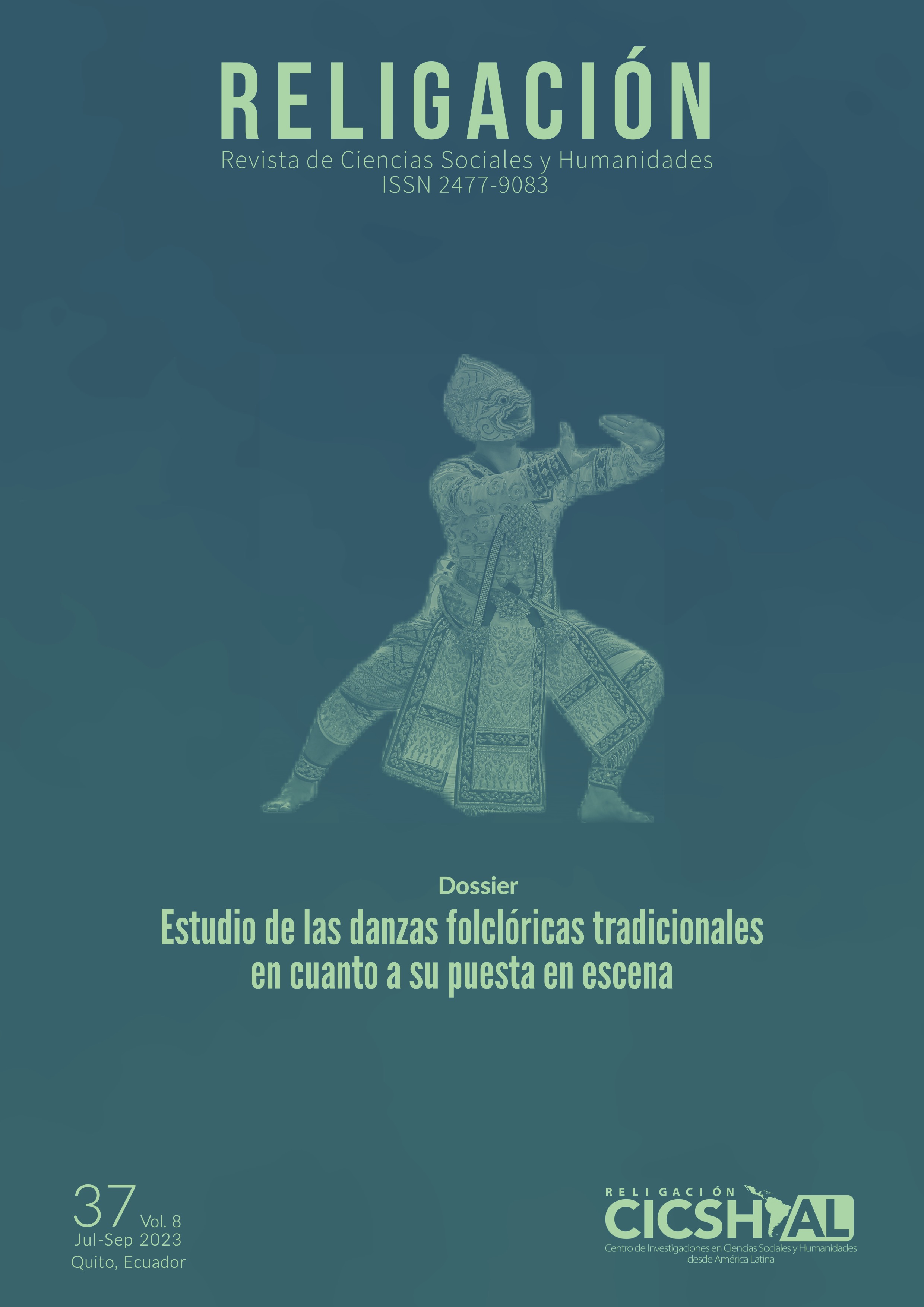¿Nihilistas e incomprendidos?: una perspectiva filosófica del cine ecuatoriano actual mediante una revisión bibliográfica y cinematográfica
Resumen
En Ecuador, son limitadas las investigaciones que abordan el cine y la filosofía con el nivel de rigor necesario. El principal obstáculo de esta escasa producción radica en la falta de una metodología adecuada para el análisis filosófico del material cinematográfico, lo que dificulta la tarea de deconstruir el discurso presente en las películas. Por tanto, el presente trabajo se centra en analizar el cine ecuatoriano desde la filosofía mediante una revisión bibliográfica y cinematográfica para conocer los problemas que se presentan en la narrativa filmográfica. Razón por la cual, se implementó una metodología cualitativa, con un enfoque descriptivo del estudio del cine ecuatoriano desde la filosofía, mediante una revisión bibliográfica y cinematográfica. Se concluyó que, el cine ecuatoriano actual tiene un componente intimista y egoísta propio del capitalismo y producto de las luchas de las clases sociales. Por lo que, este cine se centra en la clase media-alta y sus problemas existenciales, excluyendo a sectores sociales, en donde es necesario una reflexión para conocer los paradigmas y realidades de este país.
Descargas
##plugins.generic.paperbuzz.metrics##
Citas
Andrade, A.P. (2005). Democracia liberal e inestabilidad política en Ecuador. Oasis, (11), 167–190. https://revistas.uexternado.edu.co/index.php/oasis/article/view/2399
Andrade, J. (Director). (2012). Mejor no hablar (de ciertas cosas). [Película]. Punk S.A.
Araujo, D. (Director). (2014). Feriado. [Película]. Luna
Arregui, V. (Director). (2002). Fuera de juego. [Película]. Bochinche cine.
Aumont, J., Bergala, A., Marie, M., y Vernet. M. (2012). Estética del cine. Espacio fílmico, montaje, narración, lenguaje. (S. Zierer. Trad.). Paidós.
Badiuo, A. (2009). Pequeño tratado de inestética. (G. Molina, L. Vogelfang, J. L. Caputo y M. G. Burello. Trads.). Prometeo Libros.
Baumbach, N. (2019). Cinema / Politics / Philosophy. Columbia University Press.
Casetti, F. (2010). Teorías del cine. (P. Linares. Trad.). Cátedra.
Cavell, S. (1996). Contesting Tears: The Hollywood Melodrama of the Unknown Woman. Chicago University Press.
Chavolla, A., (2015). Filosofía del Cine. Sincronía, (67), 1-17.
Davies, D. (2009). The Thin Red Line. Philosophers on Film. Routledge.
Deleuze, G. (2013). La imagen-movimiento. Estudios sobre el cine 1. (I, Agoff. Trad.). Paidós.
Deleuze, G. (2014). La imagen-tiempo. Estudios sobre el cine 2. (I, Agoff, Trad.). Paidós.
Donoso, J. (Director). (2013). Saudade. [Película]. Silencio Films/Enfoque/Cineina/ Shut up & Colour Pictures
Durán, M. (2016). El cuerpo en el cine y el cuerpo del cine. Arkadin, (5), 56-71. http://papelcosido.fba.unlp.edu.ar/ojs/index.php/arkadin/article/view/134
Eaton, A. (2009). Talk to Her. Philosophes on Film. Routledge.
Gallardo, E. (2017). Metodología de la Investigación: manual autoformativo interactivo. Universidad Continental. https://cutt.ly/6NjgQLq
Habermas, J. (1989). Modernidad: un proyecto incompleto. En H. Foster (ed.). La posmodernidad. Editorial Kairos
Imbert, G. (2010). Cine e imaginarios sociales. El cine posmoderno como experiencia de los límites (1990-2010). Cátedra.
Jarvie, I. (2011). Filosofía del cine. Epistemología, ontología y estética. (C. Orstrad. Trad.). Editorial Síntesis.
León Pesántez, C. (2013). El color de la razón. Pensamiento crítico en las Américas. Corporación Editora Nacional, CEN; Universidad Andina Simón Bolívar, Sede Ecuador; Universidad de Cuenca https://repositorio.uasb.edu.ec/handle/10644/7186
Lipovetsky, G. (2015). La era del vacío. Ensayos sobre el individualismo contemporáneo. (13ra ed.) (J. Vinyoli y M. Pendanx. Trad.). Anagrama.
Luzuriaga, C., (2013). Antecedentes, inicios y problemas del cine histórico en el Ecuador: apuntes para un estudio crítico. Chasqui. Revista Latinoamericana de Comunicación, (121), 73-80.
Martínez, M. (2006). Validez y confiabilidad en la metodología cualitativa. Paradigma, 27(2).
Miño Puga, M. F. (2017). Reseña de De la Vega Velastegui, Paola (2016). Gestión cinematográfica en Ecuador: 1977-2006. Procesos, prácticas y rupturas, 1(2), 68–69. https://doi.org/10.37785/nw.v1n2.m1
Mite Basurto, A.E. (2021). Breve recorrido por el cine ecuatoriano y su representación social. Estudios del Desarrollo Social: Cuba y América Latina, 10(1). http://scielo.sld.cu/scielo.php?script=sci_arttext&pid=S2308-01322022000100011
Mora Manzano, I. (Director) (2012). Sin Otoño, Sin Primavera [Película]. La República Invisible.
Orellana, J., y Martínez J. (2010). ORELLANA, Juan; MARTÍNEZ LUCENA, Jorge: Celuloide posmoderno. Narcisismo y autenticidad en el cine actual. Filmhistoria Online, 21(1), 388. https://revistes.ub.edu/index.php/filmhistoria/article/view/13833
Pazmiño Tello, Á., & Mora, M. (2017). Cine emergente en Ecuador: Poder y corrupción El Gobernador. Ética y Cine Journal, 7(3), 63-69. https://www.redalyc.org/journal/5644/564462747008/html/
Ravelo Cabrera, P. (1998). Modernismo, posmodernidad y posmodernismo en América Latina. Filosofía en América Latina, 55(2), 420-458.
Rueda Laffond, J. C., & Chicharro Merayo, M. D. (2004). La representación cinematográfica: una aproximación al análisis sociohistórico. Ámbitos. Revista Internacional de Comunicación, (12), 427-450.
Serrano, J. (2001). El nacimiento de una noción. Apuntes sobre el cine ecuatoriano. Acuario.
Serrano Sarmiento, Á. (2019). Zigmunt Bauman (2018). Sobre la fragilidad de los vínculos humanos. Amor líquido. Barcelona: Paidós. SCIO: Revista De Filosofía, (17), 243–249. https://revistas.ucv.es/scio/index.php/scio/article/view/521
Troya, M. (2016). 10. Cambios sociales forzados por movimientos sociales: La comparación de dos ciclos políticos en Ecuador. Anuario Del Conflicto Social, (5). https://revistes.ub.edu/index.php/ACS/article/view/16008
Derechos de autor 2023 César Augusto Solano Ortiz

Esta obra está bajo licencia internacional Creative Commons Reconocimiento-NoComercial-SinObrasDerivadas 4.0.











